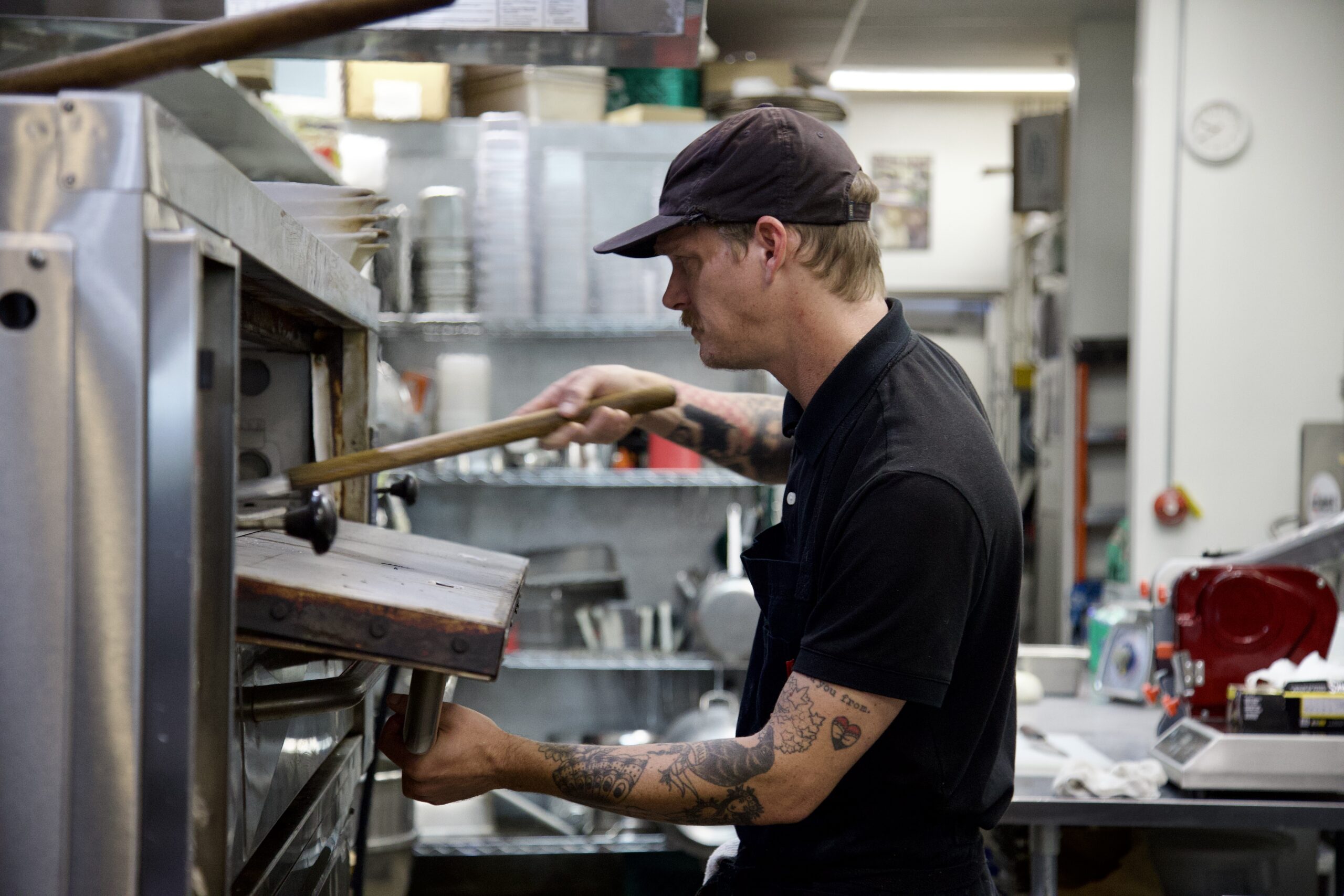
Next time you go out for a meal, pick up your plate and look at the bottom. Don’t worry because foodies do it all the time. Odds are you’ll see the words “HF Coors” stamped on the bottom, and that’s a good thing.
HF Coors Dinnerware creates some of the prettiest and most popular dishware made in the U.S., and every step that goes into every piece occurs right here in Tucson.
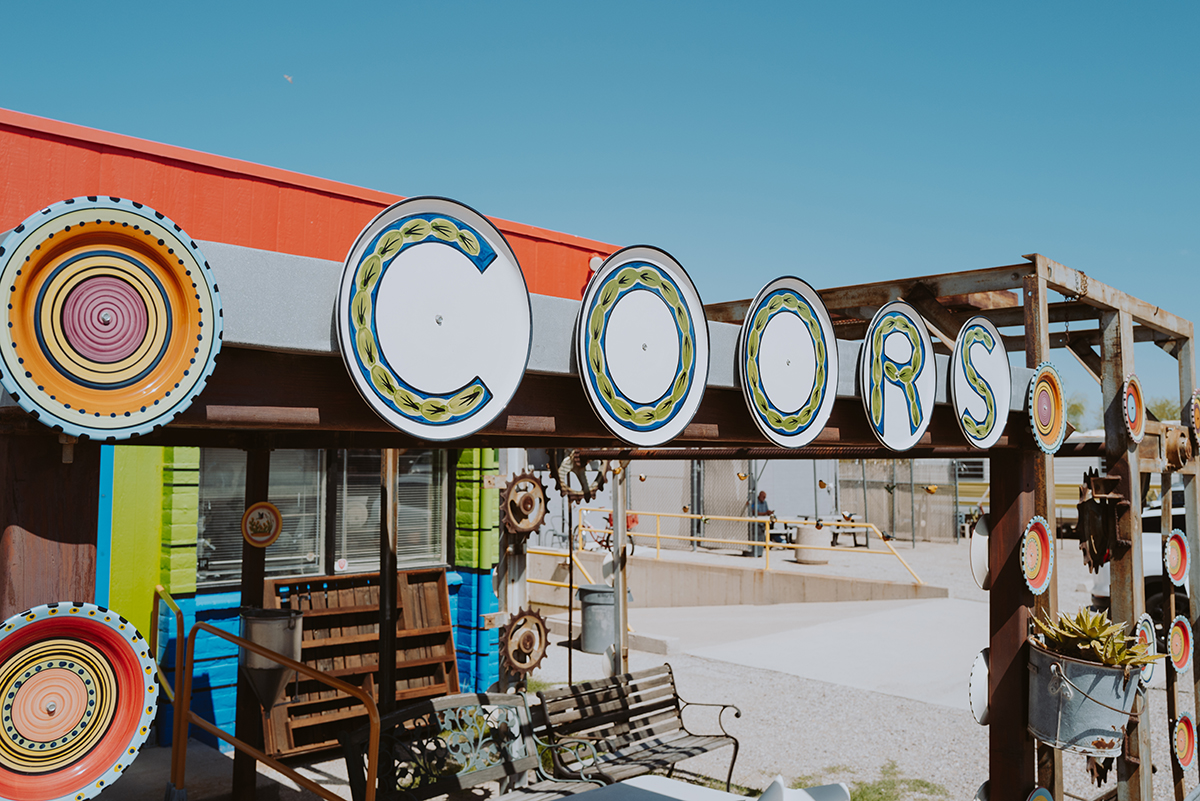
Located just south of 22nd on Cherrybell Stravenue, across from the post office, HF Coors is a true Tucson treasure. The humble exterior, which is lined by shelves stacked with “seconds” (items that don’t quite fit the standards), belies what happens in the 30,000-square-foot factory. Even the lovely gift shop where all the products are beautifully displayed gives no hint of the work done by HF Coors Dinnerware.
The original HF Coors began in 1925, as part of the Coors Brewing Company. Herman Frederik (aka HF) was the second son of Adolph Coors, and while his older brother was given the brewery, HF was charged with the bottling business, Colorado Glass Works, which made all the bottles for all that beer. Herman moved to California where the clays they needed were plentiful and easily accessible.
While the beer side had a rough go of it during Prohibition, the pottery side thrived and was given credit for keeping the brewing side in business. After a series of mergers, the company began making dinnerware and HF Coors was born. The business bought out several other small chinaware companies, which added even more products to the line.
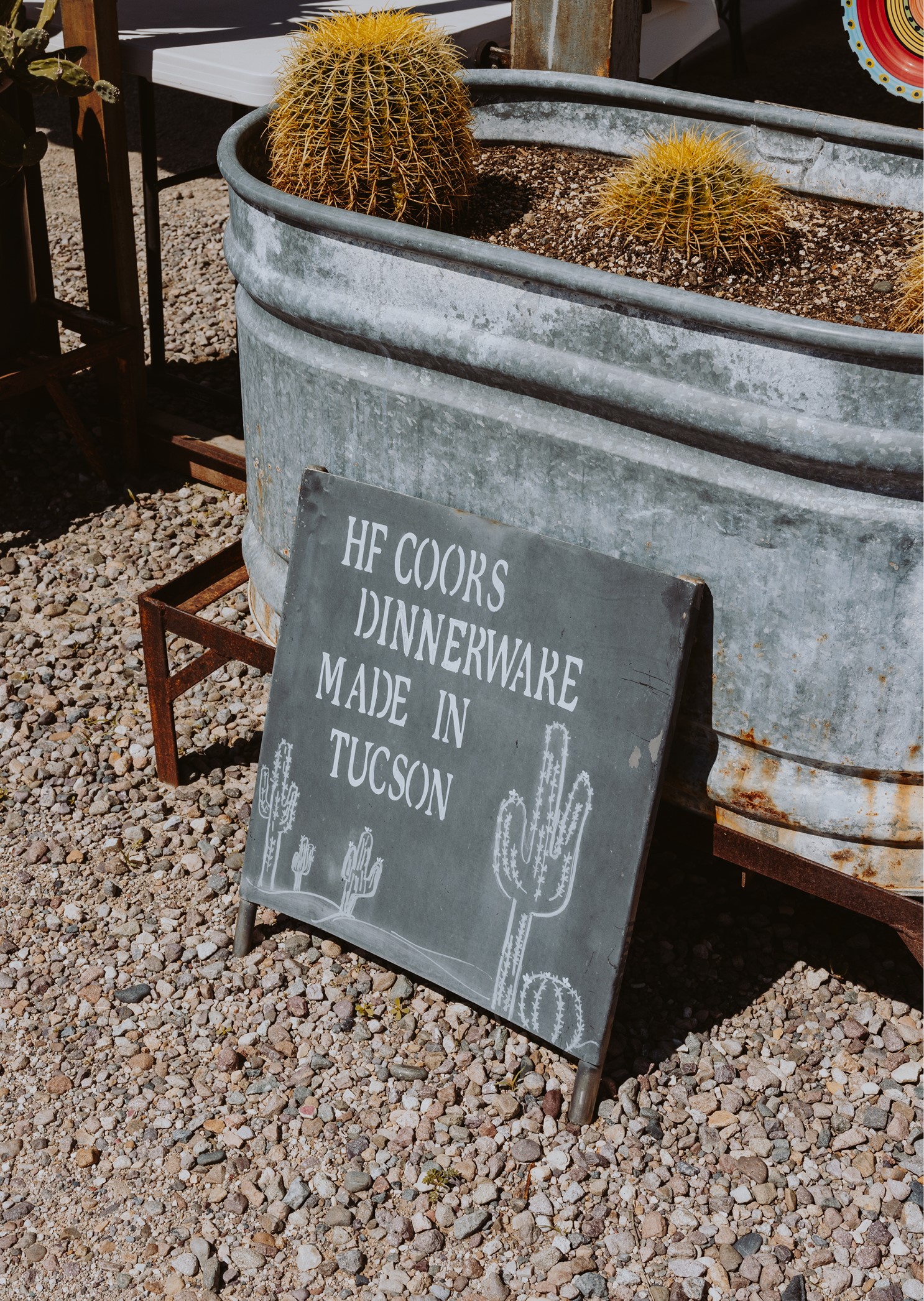
Meanwhile, back in Tucson, Dirck Schou and his partner, David Sounart, were running Catalina China, which manufactured thousands of “commodity” mugs a day. After graduating from West Point and serving in Vietnam, Schou worked for several dinnerware companies in England and the U.S. Catalina China was, in many ways, his dream job, and Tucson was the perfect place to build his company.
The cup business boomed for years, but when China stepped up its production, the increase in competition hit the business hard.
But timing, as they say, is everything. HF Coors went up for sale just about that time, and the partners bought the company. Not just the name, mind you, but literally, tons of equipment as well, all of which they then moved to Tucson. That was in 2003. Since then, the company has grown into what we got to see during our tour last week.
Both Schou and Sounart remain active in the company. Schou, CEO and President, “oversees the big picture” while Sounart is in charge of the technical side, serving as Vice President — from clay production to scheduling. But these lines aren’t hard and fast because of the size of the company.
Along for the tour was my good friend Karyn Zoldan, a fellow foodie and HF Coors fan. Read her blog Circle of Food on Facebook. She’s a great person to have on a “field trip” because she asks great questions.
Company Chief Operating Officer, Greg Goodman, was our guide. We had a full lesson in what it takes to make the iconic dinnerware. Goodman took us through the whole process in a most engaging manner. He knows his stuff, and it was obvious that he takes great pride in HF Coors products and the business operations. Plus, his kids tease him about how he always looks at the bottoms of dishes when they are out to dinner.
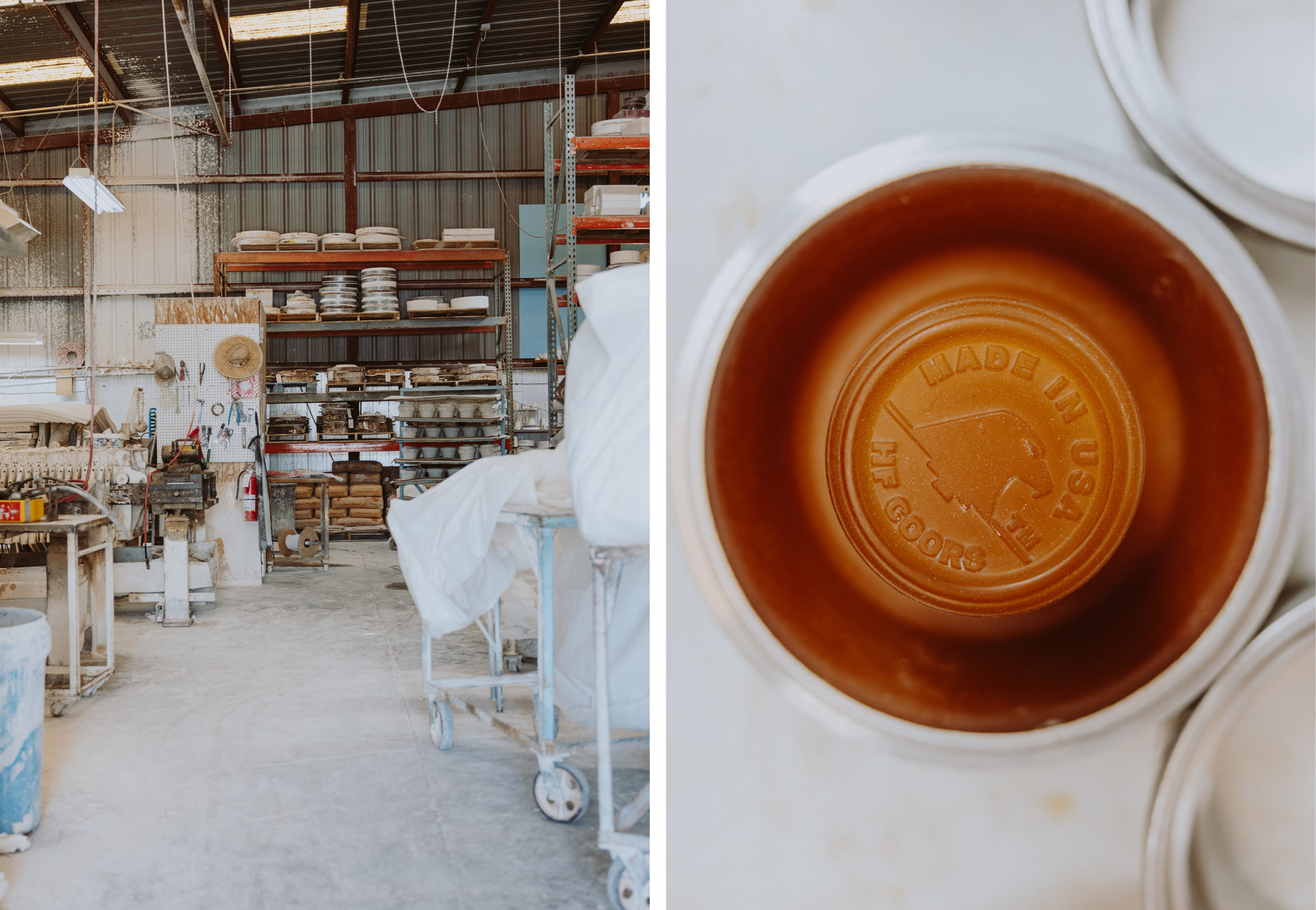
“We mix all our clays and all our glazes. Everything is made here in Tucson using American-made ingredients so we can control that,” said Goodman at the start of our tour.
He said that everything is also lead-free, BPA-free, and meets California standards for commercial pottery. He says that an encapsulated form of cadmium is used to achieve the beautiful reds found on the dinnerware. However, he notes that it does not release during firing, and when tested by independent labs the results are always “none detected.”
First stop, the clay-making area.
“Depending on what we’re making, there are different recipes for the clay, but, essentially, it’s the same ingredients,” Goodman said.
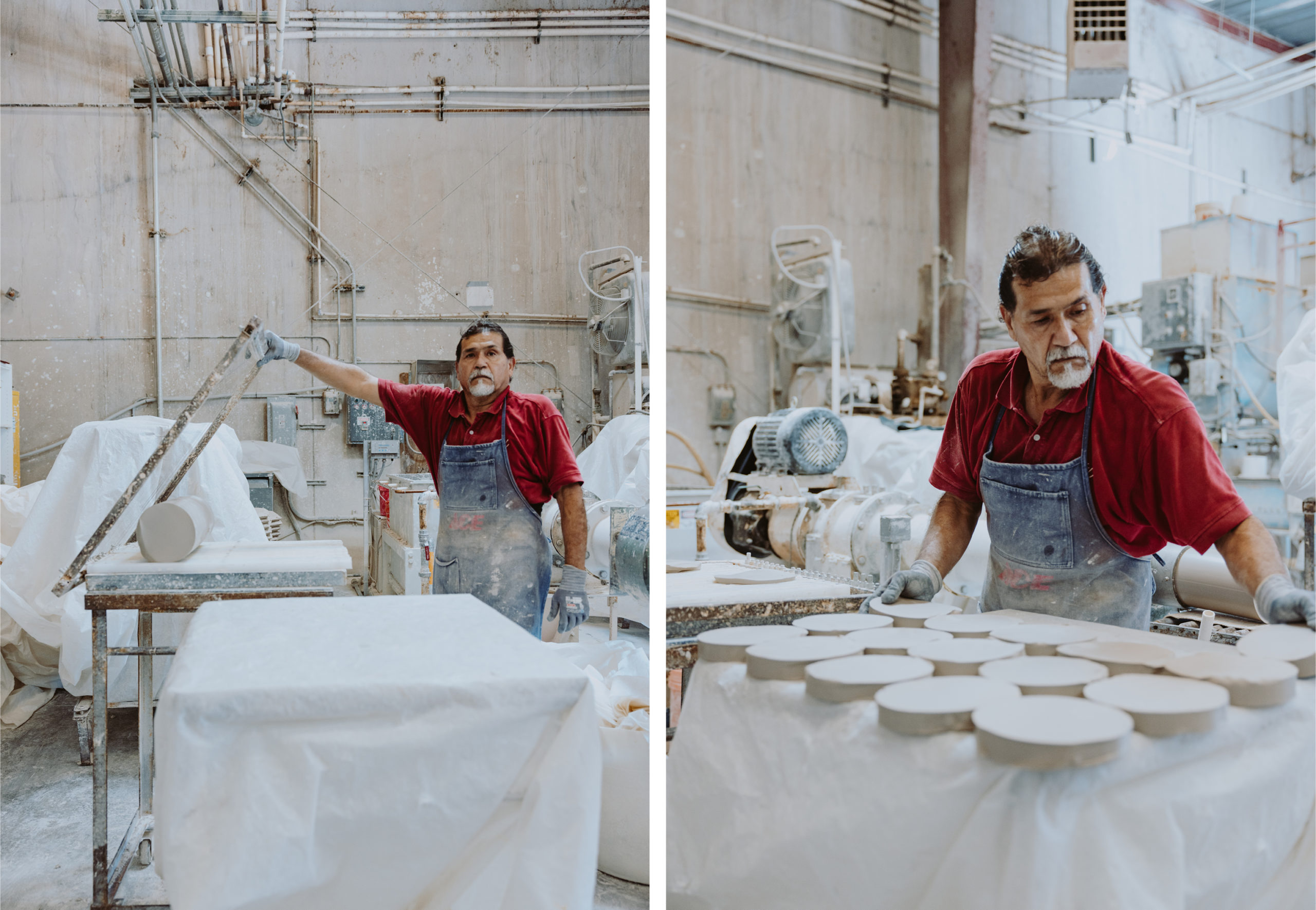
All of those ingredients are poured into a huge hopper and mixed to a certain consistency before the mix passes through a filter press that squeezes out most of the water. The mix is then transferred to a deep mixing bin where it transforms into what most of us think of when we envision clay.
Once the clay is ready, it passes through an extruder into various basic shapes using a specific fitting for each type of product. We saw thick cylinders about two feet in length and about four inches in diameter. These will be cut into several slices with a multipronged wire cutter.
The clay shapes are then sent to the mold area.
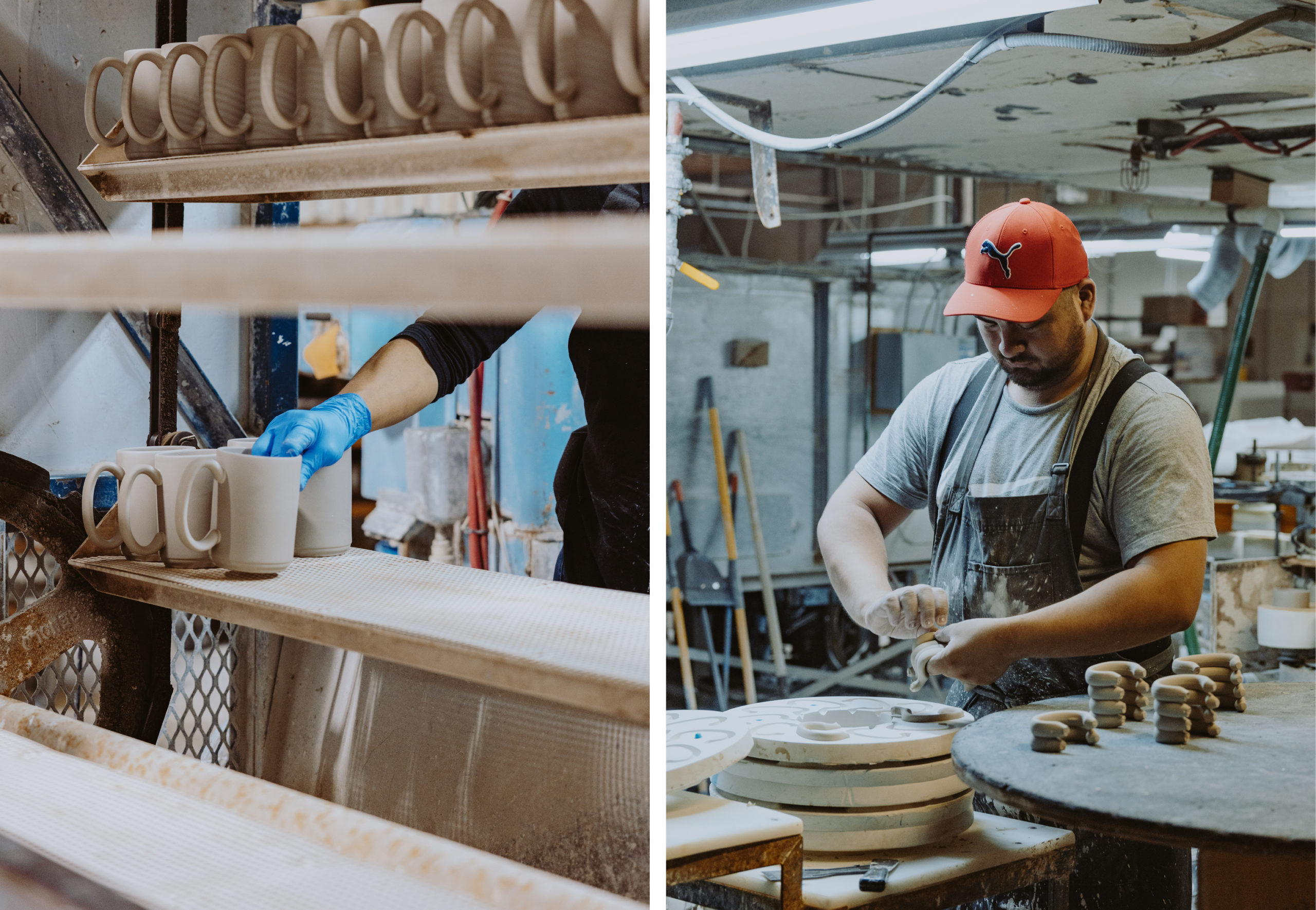
“We have a master molder,” said Goodman. “A company will come to us and say, ‘We want you to make this shape’. It’s not just a case of copying the exact thing because clay has unique properties to it. All of our clay shrinks about 12% from when you prep to the time you fire it. We have to grow it if you will.”
He notes that on average a mold is good for about 100 uses. To accommodate some of the more unusual shapes, Coors has recently started using a 3D printer.
From this point, the steps involved depend on the item being made.
Cups (and there are many different kinds of cups) head toward their molds. Plates and platters, creamers and sugar bowls, and specialty dishware (olive dishes and an assortment of ornaments) find their spot on the floor.
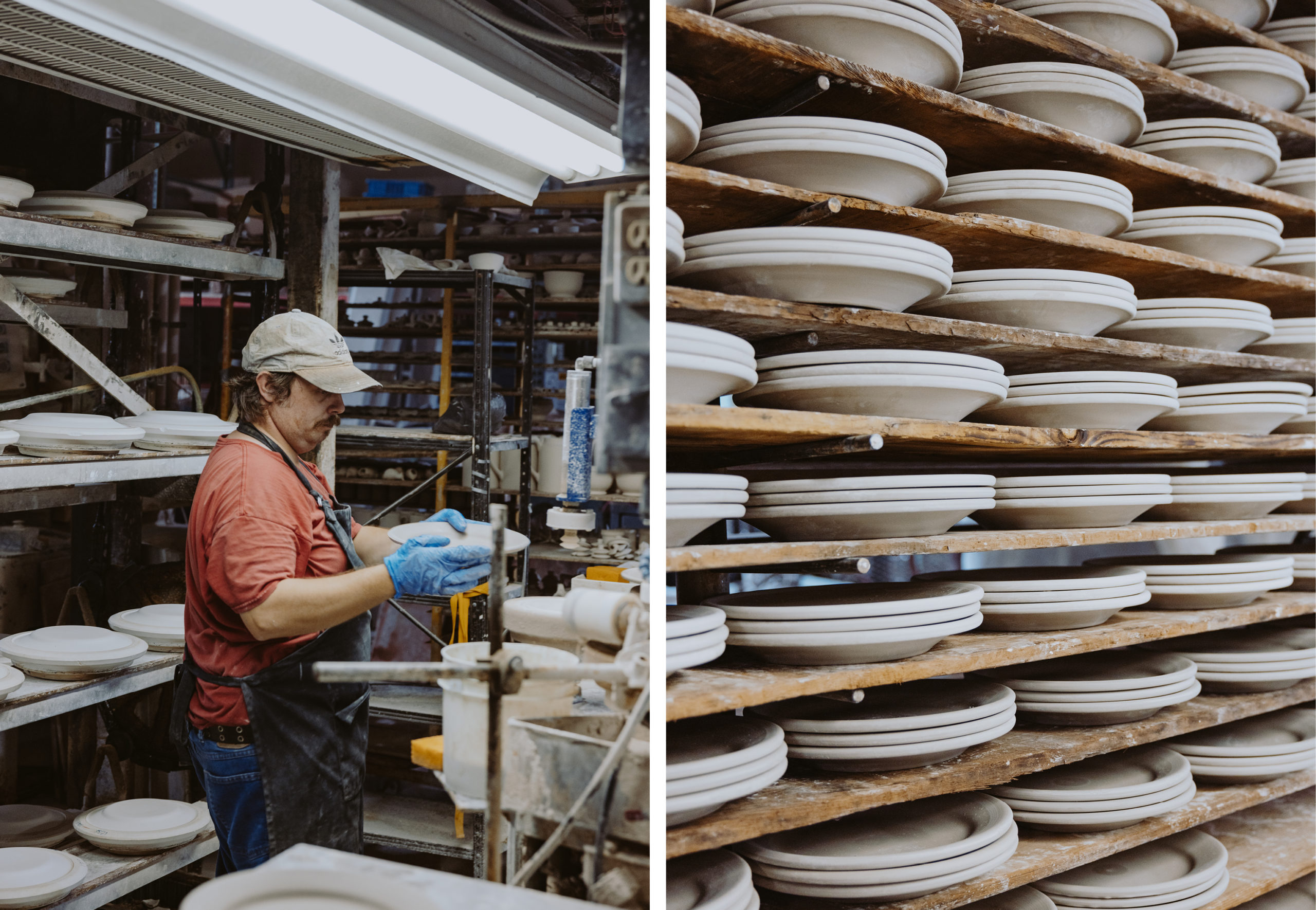
Machines spin and press and lift. One particular machine caught our attention. While a plate spins, a thin, sharp blade slides along the rim cutting off excess clay that falls in spirals of unending spaghetti-like strands into a bin. That excess will be reused in some way later on.
The machines create a constant loud hum, but make no mistake about it, this is a hands-on process. Sure, there are all sorts of huge and odd-looking machines everywhere, but humans are involved in every step. “We average about 21 human touches per piece,” said Goodman. There are approximately 60 employees. That’s a lot of hands-on.
Those hands include workers who sponge the edges of plates and such to make them smooth. Decals for specialty items are placed carefully by hand. Glazes are sprayed on, applied by hand, or a combination of both depending upon the piece. People move carts stacked with all sorts of dinnerware. Another team ships the items in eco-friendly packaging to parts beyond.
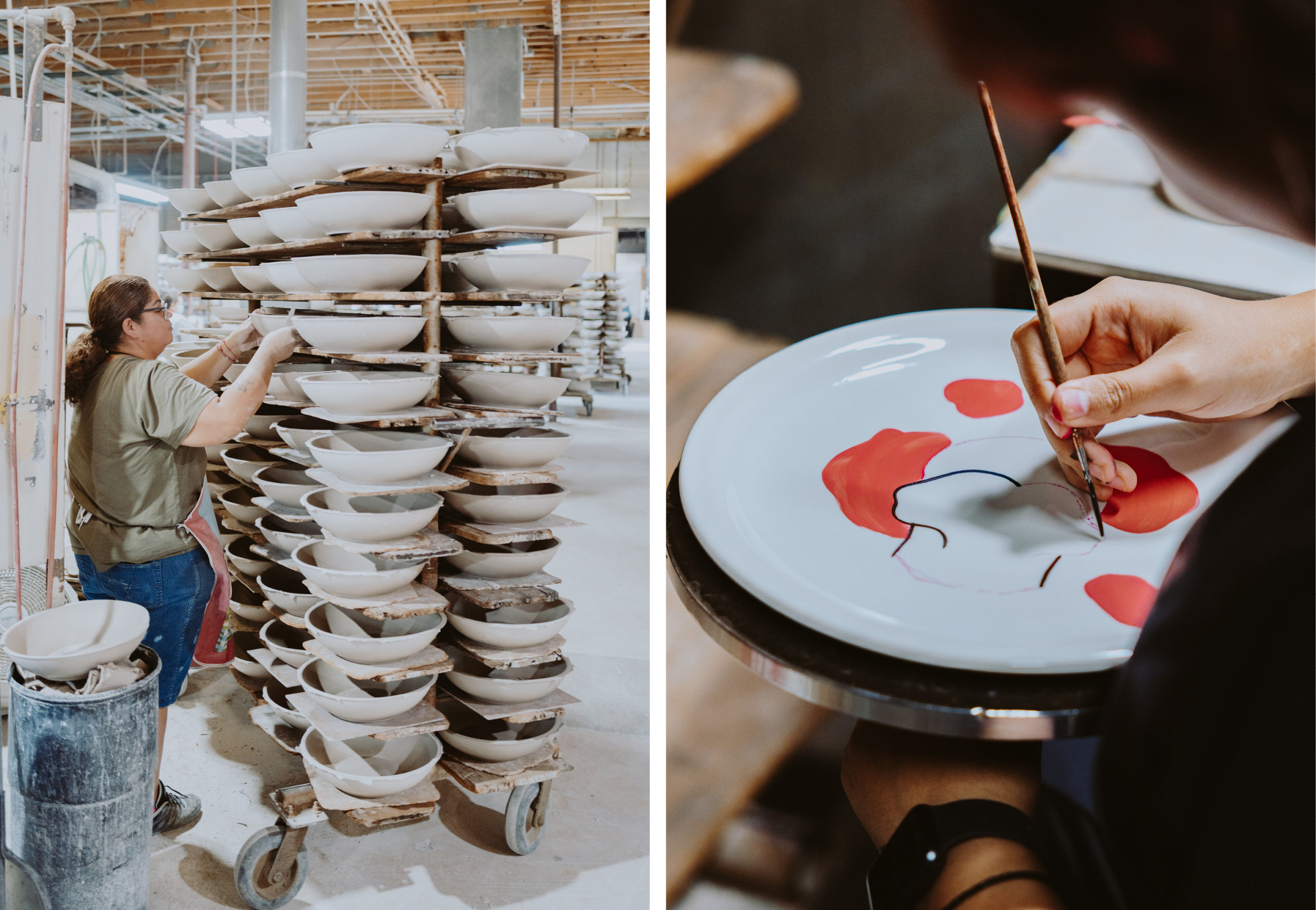
Tucked away in corners of tiny rooms, we saw a handful of artists painting patterns on the dishes, platters, and bowls. One woman was painting the Day of the Dead plates with skulls and swirls. She averages about twenty items a day. Another woman applied swaths of colors in a precise alternating color of the serape pattern. The patterns are all the same, but because humans do all the work, there can be slight differences — that’s what makes the products so special.
“They do wonderful work,” said Goodman. You can hear the admiration in his voice.
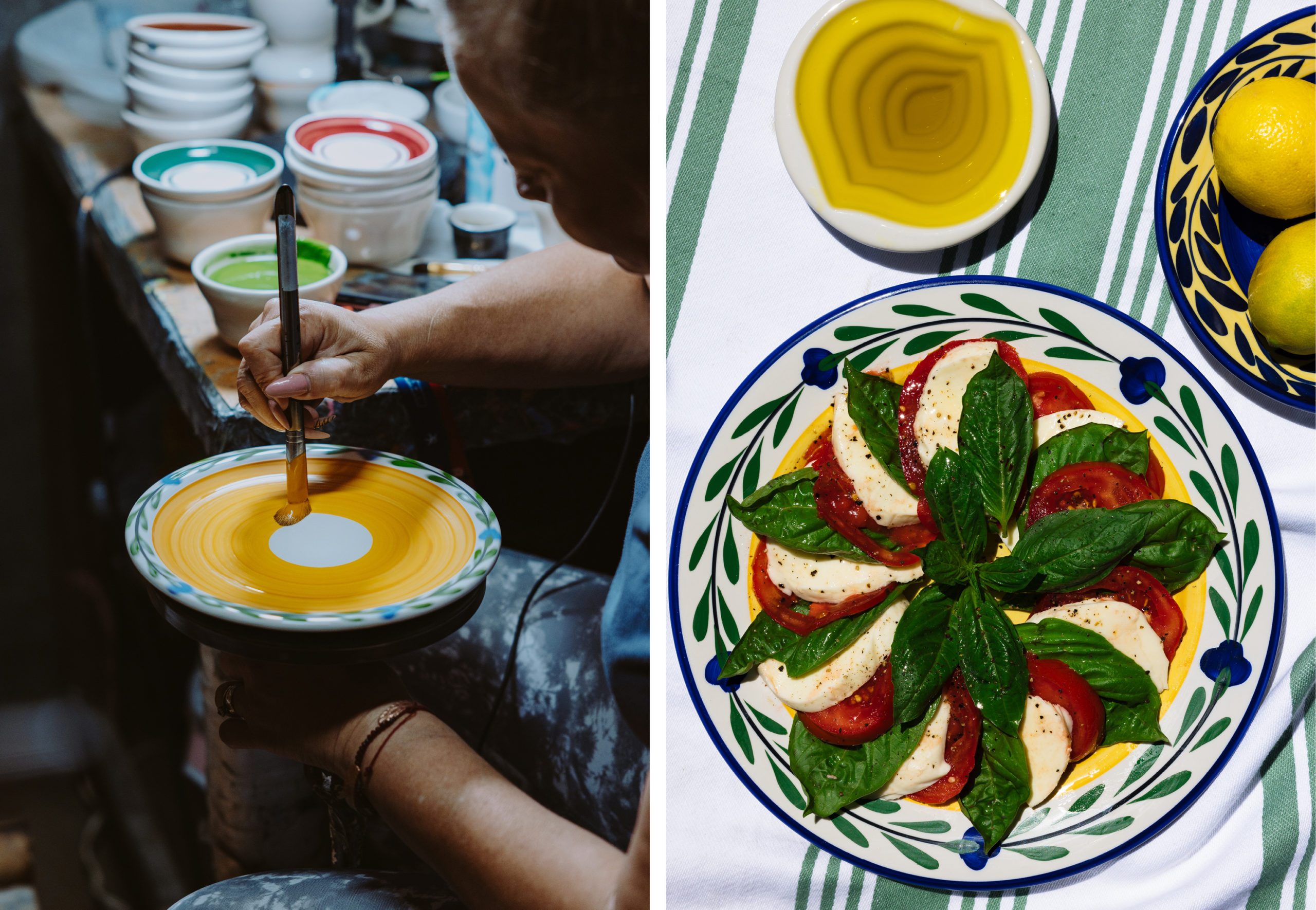
Not every item is made every day, and many employees are cross-trained to fill in as needed, but the action almost never stops, especially when it comes to the gigantic kiln.
Because demand is so great and most pieces need from nine to 11 hours to finish off, the kiln runs Tuesday through Friday for 24 hours. Everything is placed on one of 68 kiln cars that operate in a circular conveyor system that passes through the kiln and then right back out. Firing is done in stages with a cooling-off period in between. Flames could be seen at the far end from where we were standing. Kiln temperatures differ for different items, but the kiln undeniably throws off a lot of heat.
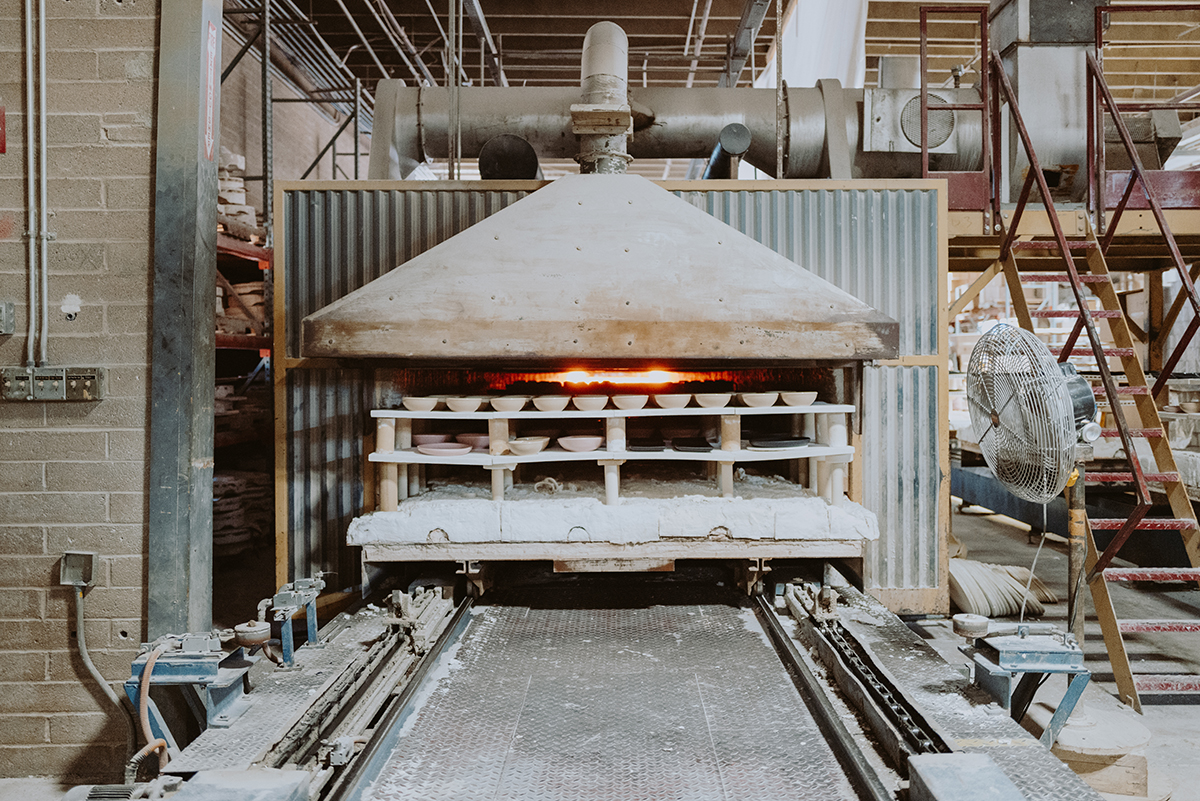
Quality control is important at every step. For instance, after a plate is glazed, a worker will sponge off the foot (the raised rim found on the bottom of dinnerware). If this is left on the item, the bottom will fuse to the kiln car. Another example is a large platter with a logo from Pizzeria Bianco that was rejected because of a small paint smear and pockmarks in the glaze.
The end result is a durable, strong, and beautiful product that’s dishwasher, oven, microwave, and broiler safe. Perfect for either home or commercial work.
Online, HF Coors has several videos including one that shows the whole process:
For the home, Coors makes about 12 different patterns for dishes, plates, bowls, creamers, sugar bowls, and other items. More are made for commercial use because restaurants often have specialty items. Goodman became interested in HF Coors through the dishes he and his wife bought in their military career. They’ve moved them seven times with only one nick in a plate.
Our illustrious leader here at Tucson Foodie, Shane Reiser, loves his HF Coors dishes. “I bought two small bowls at an antique fair. I recognized them as the same used at Penca, which I remembered admiring so much that I lifted the bowl over my head,” he said.
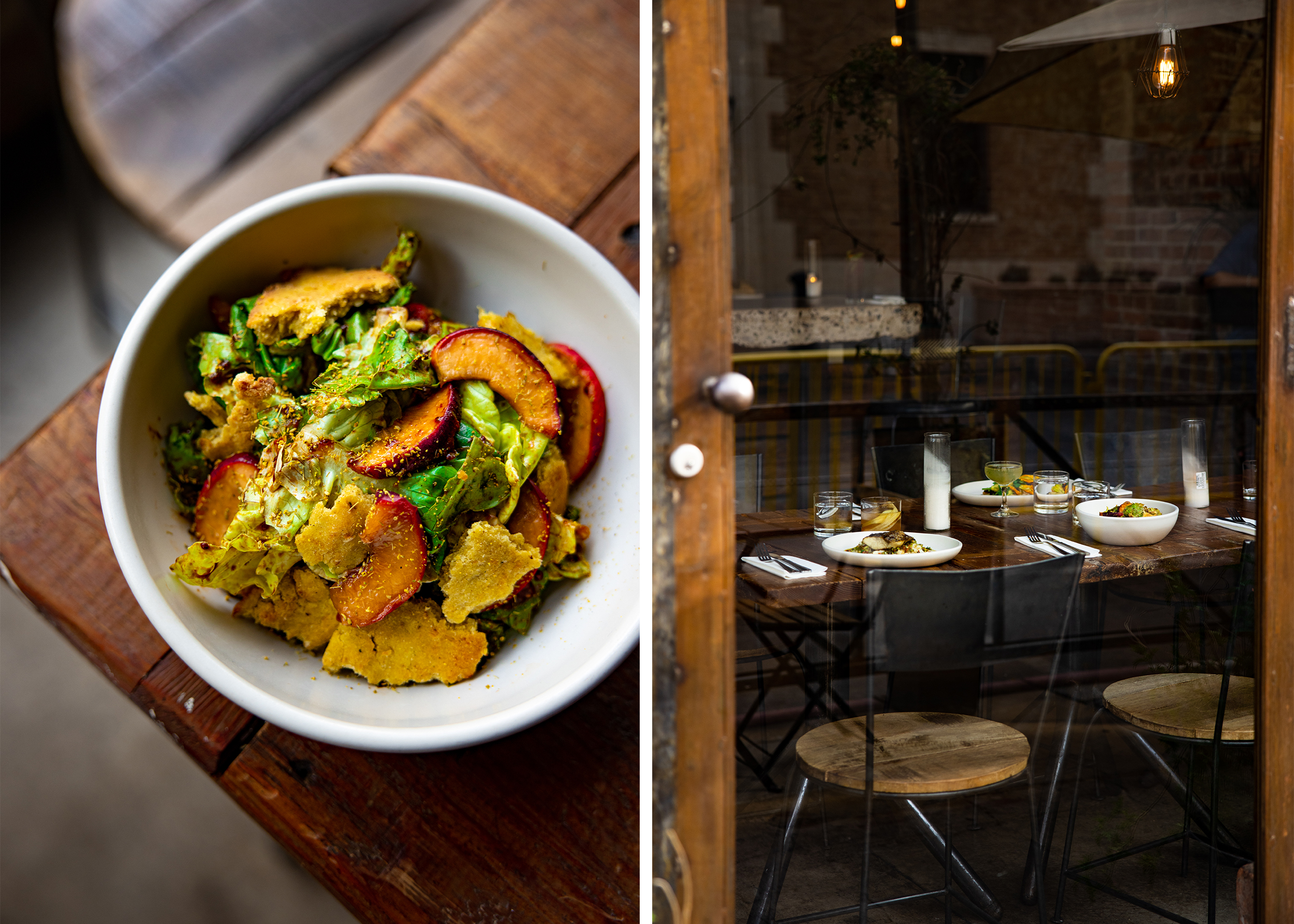 Simple Salad at Penca Restaurante on an HF Coors plate
Simple Salad at Penca Restaurante on an HF Coors plate
“They make my dishes look and taste better,” Reiser added. He’s building his collection as you’re reading this.
Restaurants appreciate the sturdiness due to the fact that breakage is minimal, the dinnerware is held through multiple washings, and they complement the food.
Local chefs rave, too.
“I’ve used them since we opened, and their product is top-notch,” said Coralie Satta, more well-known as “Chef Ghini” of Ghini’s French Caffe, which celebrated its 30th anniversary in 2022. “As many dishwashers drop dishes, they at least get one bounce. I think they are an incredible Tucson asset.”
“For years, I have turned over plates and bowls whenever I like the dinnerware at restaurants,” said Nicole Van Winden, who owns Dam Good Food with her husband, Marcus. “They are beautiful. Durable and locally made. What more could you ask for?”
Locally, you can find HF Coors products at Prep & Pastry, Beyond Bread, Zio Peppe, The Barnyard Crafthouse & Eatery, and LeBuzz Caffe. Fox Restaurant Concepts uses the products at their restaurants both locally (North Italia, Blanco Tacos, and Culinary Dropout) and nationwide. Coors also just contracted with Snooze for use in their expanding national line.
My daughter and her husband liked the dishes so much when they visited that they now use a full assortment of dinnerware at their restaurant, The Webster, in Iowa City, Iowa.
A full set of specially designed dinnerware can even be found on the set of “Yellowstone” as seen on the Paramount Network.
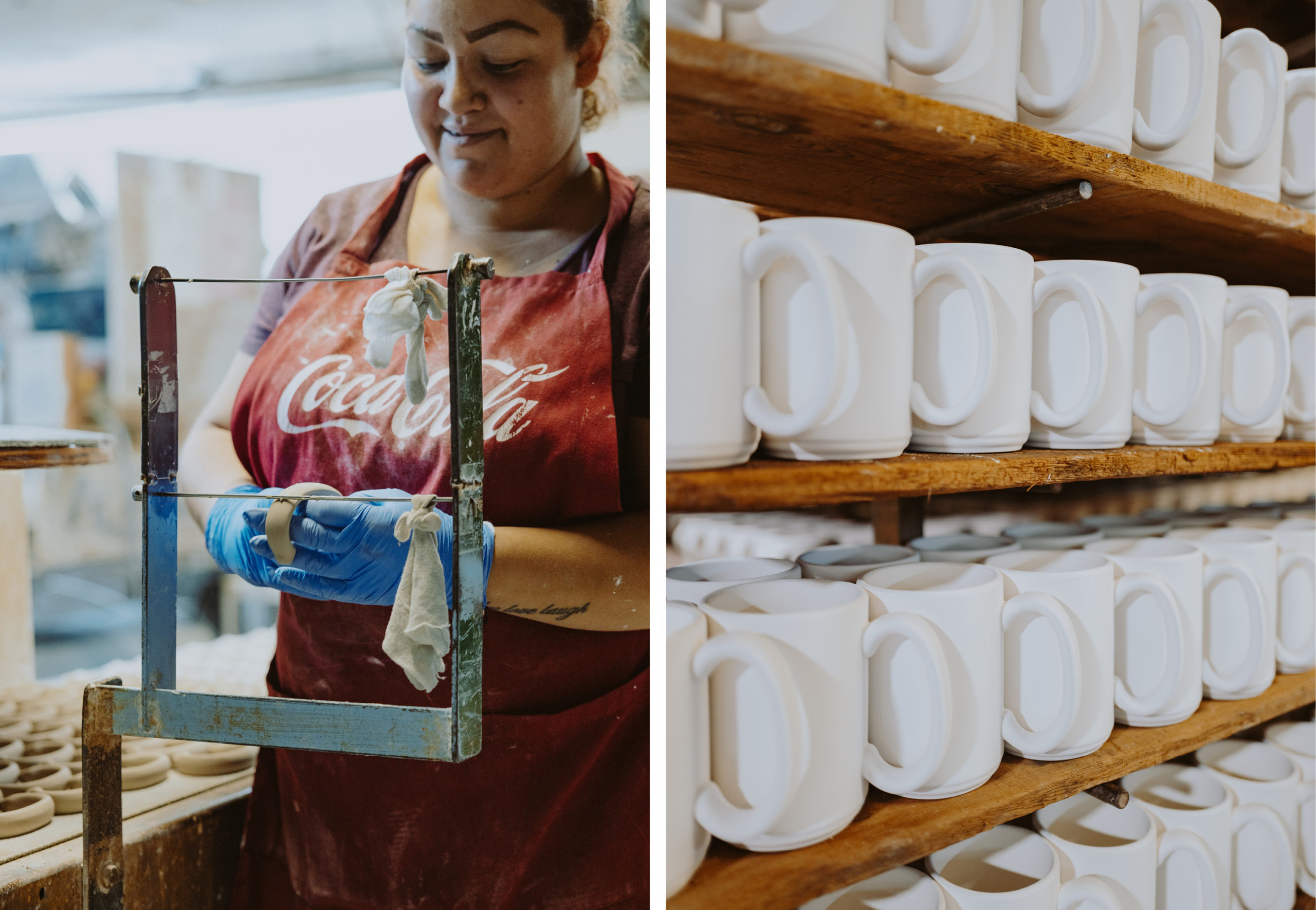
Cups, which were the starting point for Catalina China way back when, can be found on Air Force One, at several National Parks, on Navy ships, the Starbucks flagship store in Seattle, Arbuckle’s Coffee, and numerous other eateries.
The cups are great for promotion, especially during election time. A whole bipartisan collection sits in a corner with cups labeled with the names Biden, Trump, Obama, and Rush Limbaugh. Note: none of the styles, colors, or letterings are similar among those names.
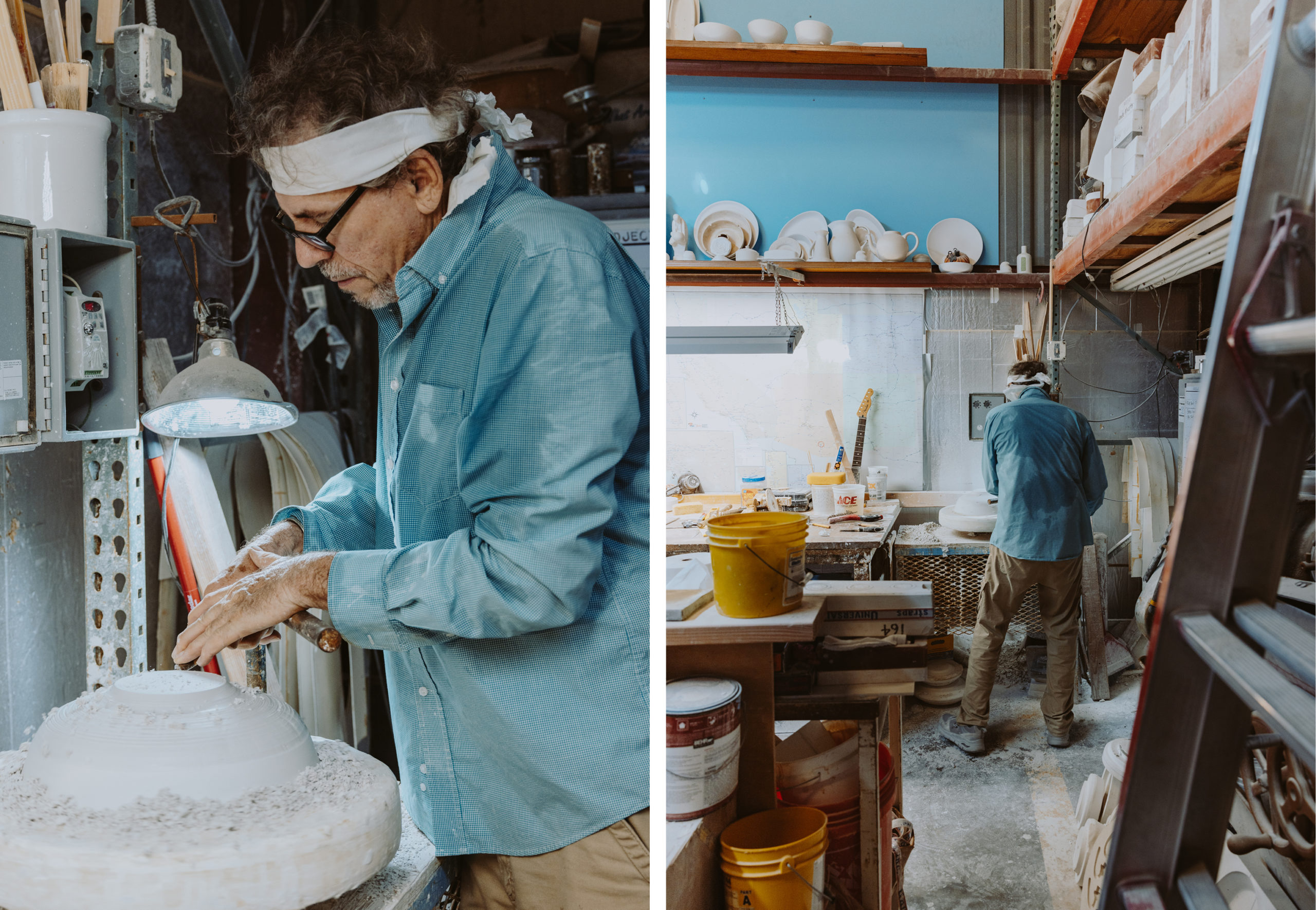
While the website offers a great way to check out all of the dinnerware that HF Coors sells, a trip to the gift shop is a must. The displays are engaging, warm, nothing fussy, and certainly welcoming. They show the true beauty of the place settings. Whether the colorful Acapulco or the simple retro Brownstone, the dishware begs to be used. Tucked in corners are tiny hummingbird ornaments, soap dishes, textured olive bowls, and an assortment of tchotchkes. Seasonal dishware changes.
Out front are the seconds — all of those pieces that either have a slight flaw or are a discontinued line.
At one time, Coors only sold these finds on “First Saturdays” at their factory store, but then they decided that setting up for a once-a-month sale took too much time away from a very busy production schedule. Now, however, you can purchase them during regular gift store hours.
Next time you dine out, make a point of checking the bottom of the plates and cups on the table. I’d make a bet that some will certainly display an “HF Coors” label.
HF Coors is located at 1600 S. Cherrybell Stravenue. For more information, visit hfcoors.com.
Tucson Foodie is a locally owned and operated community. Thanks to our partners and members, we are able to offer paywall-free guides and articles. We value your support and invite you to become a Tucson Foodie Insider today.
Rita Connelly is the author of “Lost Restaurants of Tucson,” “Historic Restaurants of Tucson,” and “Arizona Chimichangas,”all published by The History Press. Growing up in a large Italian family instilled in her an appreciation for the important role food plays...